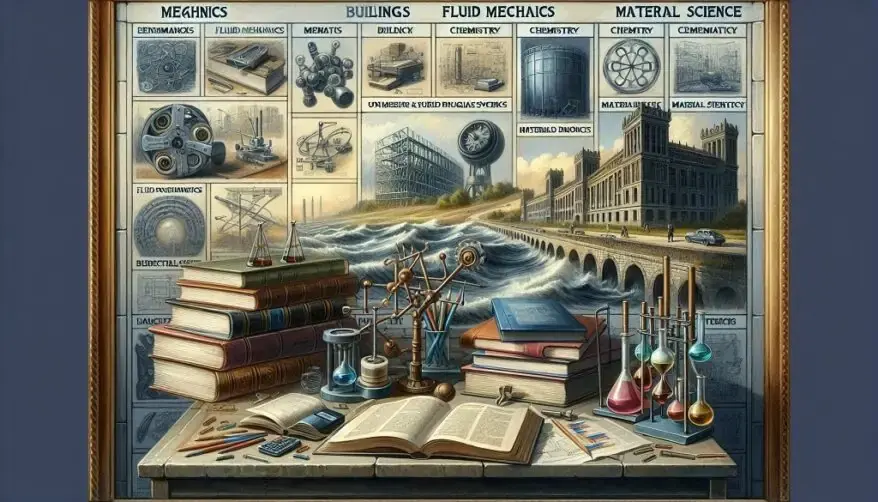Civil Engineering Explained Part II: Educational Opportunities
Estimated reading time: 10 minutes
As a 12th grade student aspiring to become a Civil Engineer, it is crucial to focus on specific topics. These topics will lay a solid foundation for your future studies and career in Civil Engineering. Basically, Key areas of focus include Mechanics, Fluid Mechanics, Chemistry, and Material Science.
Mechanics

Basically, mechanics is fundamental in analyzing Civil Engineering Structures and buildings. Specially, It focuses on the study of forces and their reactions, which is critical for understanding how structures bear loads. Additionally, key concepts include bending moments and shear forces, which are predominant in designing structures.
Understanding these forces is important for ensuring the stability and safety of buildings and infrastructure.
Fluid Mechanics

Fluid Mechanics is another vital area of study, as it plays a crucial role in various engineering applications. Not only does it involve the detailed analysis of water flow, but it is also particularly important for designing essential structures such as dams, spillways, and canals. Furthermore, a strong and in-depth understanding of fluid mechanics is absolutely essential for efficiently managing water resources and developing advanced systems that effectively regulate fluid flow through pipes. Additionally, this subject equips Civil Engineers with the necessary theoretical knowledge and practical skills to design highly efficient water supply and sewage systems, both of which are fundamentally important for sustainable urban planning and large-scale infrastructure development.
Chemistry

Chemistry plays a highly significant role in Civil Engineering, particularly in the field of material science.
To begin with, understanding the chemical reactions that occur between cement, water, and other essential ingredients like sand and stones is crucial for producing high-quality concrete.
Moreover, admixtures, which are specialized additives used to enhance the properties of concrete, also depend on fundamental chemical principles. Additionally, having a solid understanding of chemistry enables Civil Engineers to carefully select the most suitable materials for construction, ultimately ensuring durability and structural strength. For instance, knowing how different admixtures can improve concrete performance under varying environmental conditions is essential for constructing long-lasting and resilient structures.
Material Science

Material science is an integral aspect of Civil Engineering, as it involves the detailed study of the properties and applications of various construction materials. To begin with, selecting the right type of floor tile is essential not only for residential spaces but also for industrial applications, where durability and strength are key considerations. Furthermore, understanding the unique properties of materials such as timber, plastics, rubber, and metals like steel is crucial for making informed decisions in construction. In particular, steel plays a vital role in high-rise structures due to its exceptional strength and flexibility, making it indispensable in modern architecture. Additionally, a strong foundation in material science ensures that Civil Engineers can carefully select the most suitable materials for specific applications, taking into account factors such as cost-effectiveness, durability, and environmental impact.
By integrating this knowledge, engineers can design structures that are both resilient and sustainable.
Career Paths

Civil engineering offers a wide range of career paths, each with unique opportunities and challenges. Here are some potential career paths for aspiring civil engineers:
- Structural Engineering
Structural engineers focus on designing and analyzing buildings, bridges, towers, and other structures to ensure they can withstand external forces like wind and earthquakes. They consider factors such as load-bearing capacity, material strength, and stability.
- Geotechnical Engineering
Geotechnical engineers study the behavior of soil, rock, and underground water. They analyze subsurface conditions and materials to design foundations, retaining walls, tunnels, and other structures that interact with the ground. Their expertise is crucial for assessing risks related to landslides, earthquakes, and soil erosion.
- Transportation Engineering
Transportation engineers design and maintain transportation systems, such as roads, highways, railways, airports, and public transit. They focus on improving traffic flow, safety, and efficiency. Transportation engineers also develop solutions for reducing congestion and environmental impacts.
- Environmental Engineering
Environmental engineers use engineering principles, soil science, biology, and chemistry to develop solutions to environmental problems. They work on projects like waste management, water treatment, pollution control, and sustainable development. Their goal is to protect human and environmental health by designing systems that minimize environmental impacts.
- Water Resources Engineer
Water resources engineers are responsible for water supply and distribution, flood control, irrigation, and drainage systems. They design dams, reservoirs, canals, and pipelines to ensure a reliable and safe water supply. Their work is critical in managing water resources, especially in areas prone to drought or flooding.
You need a 4-year undergraduate degree program to complete the program in either Bachelor of Civil Engineering (B E Civil) or Bachelor of Technology in Civil Engineering (B Tech Civil).
Fundamental Principles for Civil Engineers
Civil Engineers base their professional careers on the following fundamental principles as outlined by the American Society of Civil Engineers (ASCE):
- Prioritize the health, safety, and welfare of the public.
- Improve the quality of life for humans.
- Reduce negative societal, environmental, and economic impacts.
- Utilize resources efficiently and minimize depletion.
- Promote and demonstrate inclusive, equitable, and ethical behavior in all interactions with colleagues.
- Report violations of the Code of Ethics to the American Society of Civil Engineers.
NEP 2020

Basically, india has proactively implemented the NEP 2020 to ensure the holistic development of students by emphasizing not only the necessary skills but also the essential knowledge in their respective disciplines. Specifically, for a B. Tech in Civil Engineering, students are required to complete approximately 22 credits per semester, ultimately totaling 176 credits over the span of eight semesters.
Furthermore, NEP 2020 prescribes a well-structured curriculum that mandates students to complete various academic components, including seminars, mini projects, capstone projects, assignments, and both written and viva voce examinations. Moreover, these assessments are carefully designed to evaluate students based on both practical and theoretical courses. As a result, this approach ensures a well-rounded educational experience, fostering comprehensive learning and the holistic development of students.
Useful Software for Civil Engineers

Civil engineers require a diverse set of software skills to handle the various aspects of planning, designing, analyzing, and managing construction projects. Here is a comprehensive list of essential software skills for civil engineers:
Design and Drafting Software
AutoCAD: Widely used for 2D and 3D drafting, Essential for creating detailed construction drawings and site plans.
Revit: A Building Information Modeling (BIM) software, Used for 3D modeling, coordination, and clash detection.
MicroStation: Another powerful CAD software used for infrastructure projects. MicroStation is renowned for its precision in civil and architectural designs.
Structural Analysis and Design Software
STAAD.Pro: Used for structural analysis and design of buildings, bridges, towers, and more. Supports various international design codes.
SAP2000: Comprehensive software for structural analysis and design. Additionally, this software is particularly useful for complex structural systems and dynamic analysis.
ETABS: Specialized in the analysis and design of building systems. The system includes integrated modeling, analysis, and design tools.
ANSYS: Used for advanced structural analysis. ANSYS utilizes finite element analysis (FEA) to analyze stress, strain, and deformation.
Geotechnical Analysis Software
PLAXIS: Finite element software for geotechnical applications. It is utilized for the analysis of soil-structure interaction, foundations, and tunneling.
GeoStudio: Suite of products for geotechnical modeling. The suite of products includes tools for analyzing slope stability, seepage, and stress-deformation.
SAFE: Specialized in foundation and floor system analysis and design. Additionally, integrates modeling, analysis, and design capabilities.
Hydraulic and Hydrological Modeling Software
HEC-RAS: Hydraulic modeling software for river and stream analysis. Floodplain management and floodway modeling utilize this software.
SWMM (Storm Water Management Model): Used for planning, analysis, and design of storm water runoff, wastewater, and combined sewer systems.
EPANET: Models water distribution piping systems. Additionally, the program analyzes the hydraulics and water quality within pressurized pipe networks.
Environmental and Sustainability Software
Envi-met: This tool simulates the interactions between surfaces, plants, and air in urban settings. Additionally, It aids in evaluating the ecological consequences of urban planning.
Project Management and Scheduling Software
Microsoft Project is a powerful project management software designed for planning, scheduling, and tracking progress. More specifically, it is particularly useful for efficiently allocating resources and closely monitoring project timelines. Additionally, it helps project managers streamline workflows, identify potential bottlenecks, and ensure that tasks are completed on schedule. By providing comprehensive tools for project tracking and resource management, Microsoft Project enhances overall efficiency and productivity, making it an essential tool for successful project execution.
Geographic Information System (GIS) Software
ArcGIS: GIS software for mapping and spatial analysis. ArcGIS finds its application in infrastructure planning, environmental management, and urban planning.
QGIS: Open-source GIS software. It provides robust mapping and spatial data analysis capabilities.
Construction Management Software
Procore: Cloud-based construction management software. Manages project documentation, coordination, and communication.
Bluebeam Revu: PDF markup and collaboration software. Useful for reviewing and annotating construction documents and plans.
Miscellaneous Tools
MATLAB: Used for numerical computing and algorithm development. Helpful for data analysis and simulation in various civil engineering applications.
SketchUp: 3D modeling software. It is utilized to generate initial architectural blueprints and illustrations.
Programming and Scripting Skills
Python: Useful for automating tasks, data analysis, and custom tool development. Python is widely used for scripting in GIS and data processing.
VBA (Visual Basic for Applications): Scripting language for automating tasks in Microsoft Office applications like Excel. Additionally, it is particularly beneficial for tasks related to project management and data analysis.
Presentation and Documentation Software
Microsoft Office Suite: Includes Word, Excel, and PowerPoint. This suite is essential for documentation, data analysis, and presentations.
Additionally, by developing proficiency in these software tools, civil engineers can enhance their technical capabilities, additionally improve project efficiency, and deliver high-quality engineering solutions.
Concluding Remarks
How ever, 12th-grade Civil Engineering student, it is absolutely essential to study key subject areas such as Mechanics, Fluid Mechanics, Chemistry, and Material Science. Additionally, To begin with, these subjects play a crucial role in developing a deep understanding of structures, ensuring building stability, and effectively managing water resources. Furthermore, Chemistry is particularly important for selecting the most suitable construction materials, as it helps in understanding the chemical interactions that contribute to material strength and durability. Additionally, Material Science is vital for choosing the best materials for specific applications, balancing factors such as cost, longevity, and environmental sustainability.
Basically, Civil engineers need a 4-year undergraduate degree program to complete a Bachelor of Civil Engineering or Bachelor of Technology in Civil Engineering. They follow the American Society of Civil Engineers’ principles, which prioritize public health, safety, and welfare, additionally improve human quality of life, reduce negative impacts, and use resources efficiently. India’s NEP 2020 focuses on holistic development of students, with a B. Tech in Civil Engineering program requiring 22 credits per semester.
Essential software skills for civil engineers include AutoCAD, Revit, Stad. Pro, SAP2000, ETABS, ANSYS, PLAXIS, GeoStudio, SAFE, HEC-RAS, SWMM, EPANET, and Envi-met
Additionally, Project management software, GIS software, and Microsoft Office Suite are also essential. Proficiency in these software tools can enhance technical capabilities, improve project efficiency, and deliver high-quality engineering solutions.
Thanks for reading!
Additionally, to stay updated with the latest developments in STEM research, visit ENTECH Online. Basically, this is our digital magazine for science, technology, engineering, and mathematics. Furthermore, at ENTECH Online, you’ll find a wealth of information.






Intersting!
Very much useful information
Thanks for your comment, keep visiting entechonline.com for more articles related to your interests.